HNN 217, Deakin University: Nursing Role in HIV Prevention Essay
VerifiedAdded on 2022/11/26
|12
|3426
|433
Essay
AI Summary
This essay examines the pivotal role of primary healthcare nurses in preventing HIV exposure, particularly within at-risk populations. It emphasizes the importance of education, community outreach, and the implementation of evidence-based practices. The essay highlights the nurses' responsibilities in providing information, promoting testing, and connecting individuals with care and support services. It addresses the social determinants of health, such as poverty and lack of education, and how nurses can address these factors to improve HIV prevention efforts. The essay also explores the significance of cultural sensitivity and the need for tailored interventions to meet the diverse needs of communities, including indigenous populations. Furthermore, it underscores the importance of nurses in advocating for improved access to healthcare and reducing health disparities. The essay concludes by emphasizing the critical role of nurses in fostering therapeutic relationships and engaging communities in comprehensive HIV prevention programs.

Running Head: NURSING ROLE
0
Role of nurses in HIV prevention
Essay
student
5/16/2019
0
Role of nurses in HIV prevention
Essay
student
5/16/2019
Paraphrase This Document
Need a fresh take? Get an instant paraphrase of this document with our AI Paraphraser
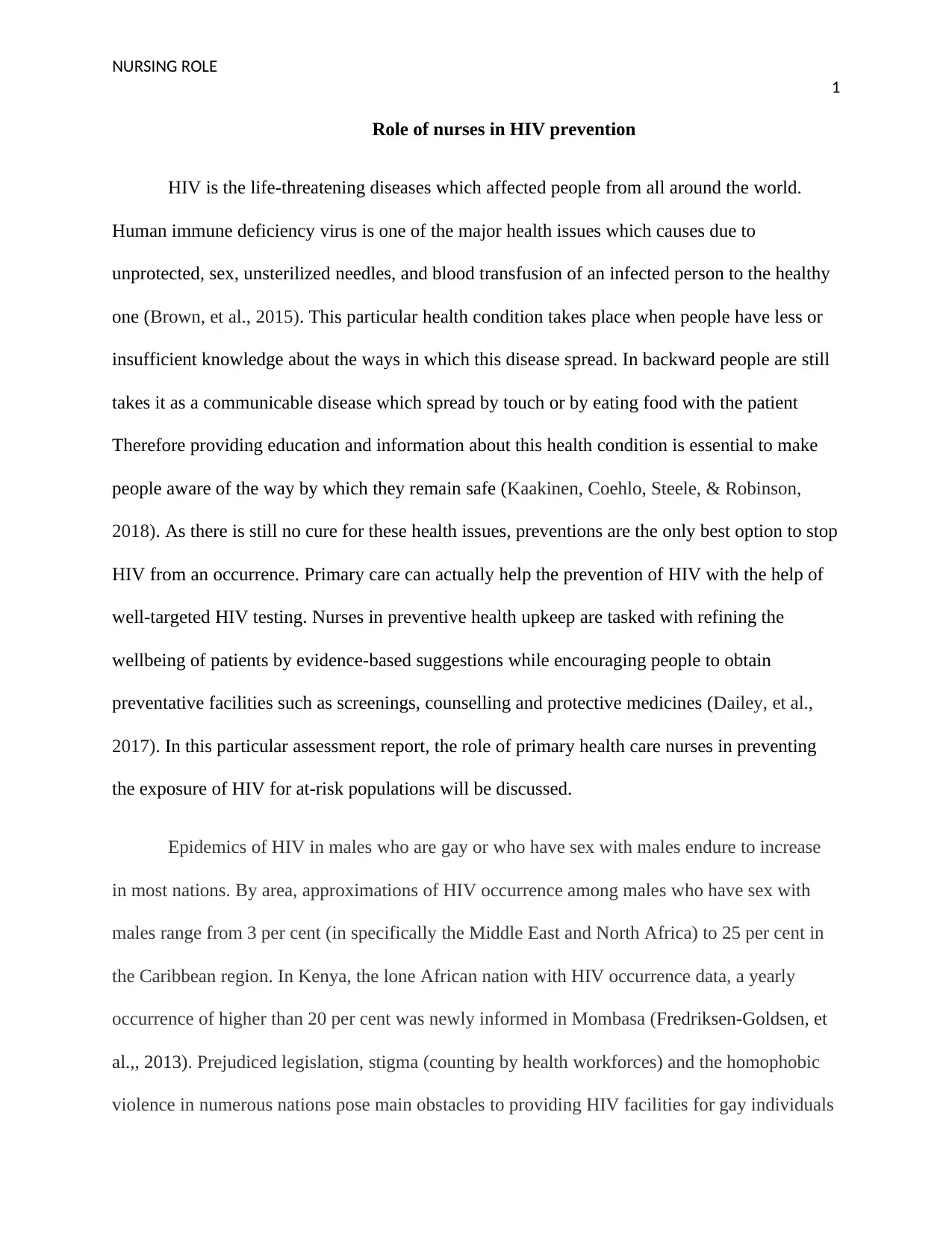
NURSING ROLE
1
Role of nurses in HIV prevention
HIV is the life-threatening diseases which affected people from all around the world.
Human immune deficiency virus is one of the major health issues which causes due to
unprotected, sex, unsterilized needles, and blood transfusion of an infected person to the healthy
one (Brown, et al., 2015). This particular health condition takes place when people have less or
insufficient knowledge about the ways in which this disease spread. In backward people are still
takes it as a communicable disease which spread by touch or by eating food with the patient
Therefore providing education and information about this health condition is essential to make
people aware of the way by which they remain safe (Kaakinen, Coehlo, Steele, & Robinson,
2018). As there is still no cure for these health issues, preventions are the only best option to stop
HIV from an occurrence. Primary care can actually help the prevention of HIV with the help of
well-targeted HIV testing. Nurses in preventive health upkeep are tasked with refining the
wellbeing of patients by evidence-based suggestions while encouraging people to obtain
preventative facilities such as screenings, counselling and protective medicines (Dailey, et al.,
2017). In this particular assessment report, the role of primary health care nurses in preventing
the exposure of HIV for at-risk populations will be discussed.
Epidemics of HIV in males who are gay or who have sex with males endure to increase
in most nations. By area, approximations of HIV occurrence among males who have sex with
males range from 3 per cent (in specifically the Middle East and North Africa) to 25 per cent in
the Caribbean region. In Kenya, the lone African nation with HIV occurrence data, a yearly
occurrence of higher than 20 per cent was newly informed in Mombasa (Fredriksen-Goldsen, et
al.,, 2013). Prejudiced legislation, stigma (counting by health workforces) and the homophobic
violence in numerous nations pose main obstacles to providing HIV facilities for gay individuals
1
Role of nurses in HIV prevention
HIV is the life-threatening diseases which affected people from all around the world.
Human immune deficiency virus is one of the major health issues which causes due to
unprotected, sex, unsterilized needles, and blood transfusion of an infected person to the healthy
one (Brown, et al., 2015). This particular health condition takes place when people have less or
insufficient knowledge about the ways in which this disease spread. In backward people are still
takes it as a communicable disease which spread by touch or by eating food with the patient
Therefore providing education and information about this health condition is essential to make
people aware of the way by which they remain safe (Kaakinen, Coehlo, Steele, & Robinson,
2018). As there is still no cure for these health issues, preventions are the only best option to stop
HIV from an occurrence. Primary care can actually help the prevention of HIV with the help of
well-targeted HIV testing. Nurses in preventive health upkeep are tasked with refining the
wellbeing of patients by evidence-based suggestions while encouraging people to obtain
preventative facilities such as screenings, counselling and protective medicines (Dailey, et al.,
2017). In this particular assessment report, the role of primary health care nurses in preventing
the exposure of HIV for at-risk populations will be discussed.
Epidemics of HIV in males who are gay or who have sex with males endure to increase
in most nations. By area, approximations of HIV occurrence among males who have sex with
males range from 3 per cent (in specifically the Middle East and North Africa) to 25 per cent in
the Caribbean region. In Kenya, the lone African nation with HIV occurrence data, a yearly
occurrence of higher than 20 per cent was newly informed in Mombasa (Fredriksen-Goldsen, et
al.,, 2013). Prejudiced legislation, stigma (counting by health workforces) and the homophobic
violence in numerous nations pose main obstacles to providing HIV facilities for gay individuals
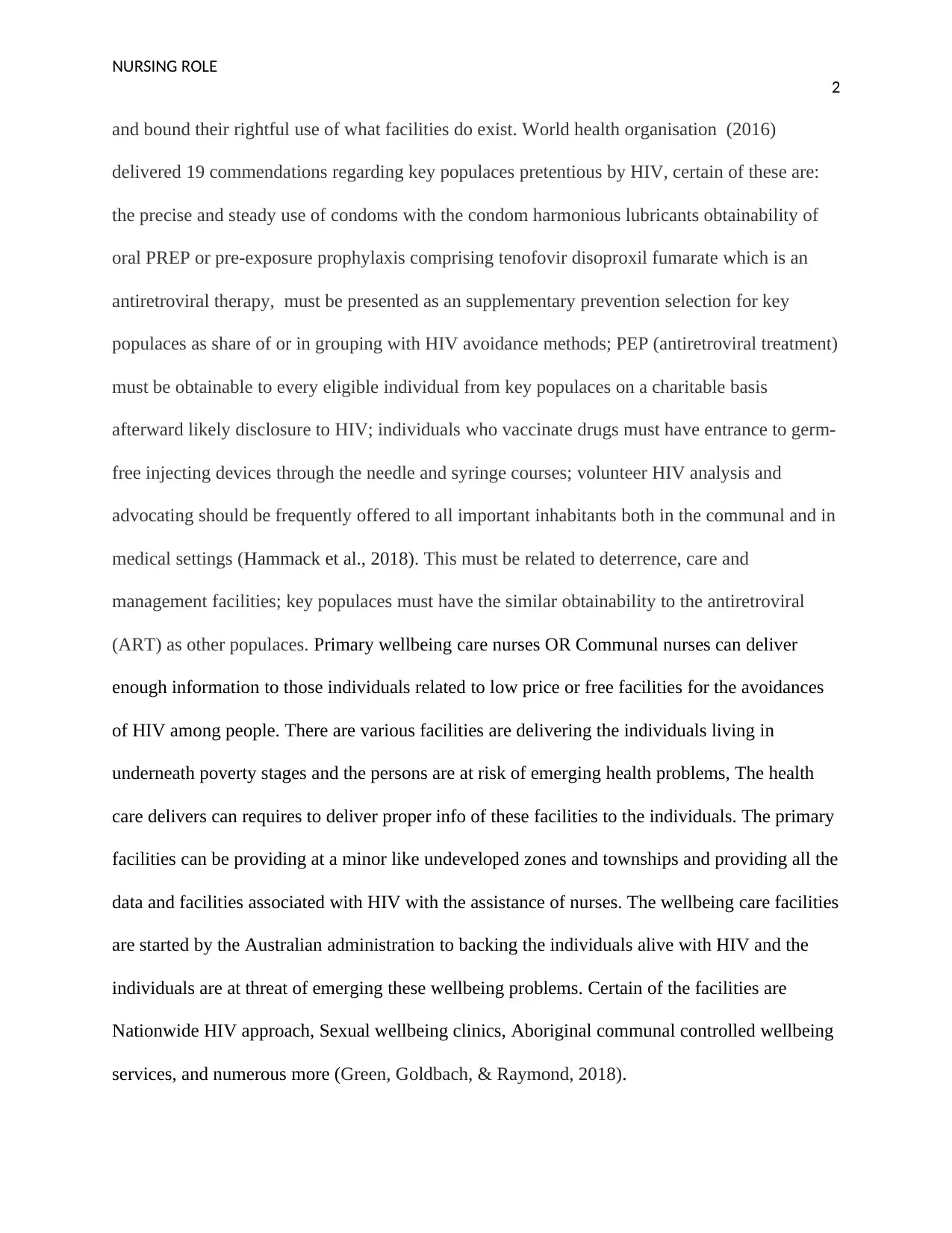
NURSING ROLE
2
and bound their rightful use of what facilities do exist. World health organisation (2016)
delivered 19 commendations regarding key populaces pretentious by HIV, certain of these are:
the precise and steady use of condoms with the condom harmonious lubricants obtainability of
oral PREP or pre-exposure prophylaxis comprising tenofovir disoproxil fumarate which is an
antiretroviral therapy, must be presented as an supplementary prevention selection for key
populaces as share of or in grouping with HIV avoidance methods; PEP (antiretroviral treatment)
must be obtainable to every eligible individual from key populaces on a charitable basis
afterward likely disclosure to HIV; individuals who vaccinate drugs must have entrance to germ-
free injecting devices through the needle and syringe courses; volunteer HIV analysis and
advocating should be frequently offered to all important inhabitants both in the communal and in
medical settings (Hammack et al., 2018). This must be related to deterrence, care and
management facilities; key populaces must have the similar obtainability to the antiretroviral
(ART) as other populaces. Primary wellbeing care nurses OR Communal nurses can deliver
enough information to those individuals related to low price or free facilities for the avoidances
of HIV among people. There are various facilities are delivering the individuals living in
underneath poverty stages and the persons are at risk of emerging health problems, The health
care delivers can requires to deliver proper info of these facilities to the individuals. The primary
facilities can be providing at a minor like undeveloped zones and townships and providing all the
data and facilities associated with HIV with the assistance of nurses. The wellbeing care facilities
are started by the Australian administration to backing the individuals alive with HIV and the
individuals are at threat of emerging these wellbeing problems. Certain of the facilities are
Nationwide HIV approach, Sexual wellbeing clinics, Aboriginal communal controlled wellbeing
services, and numerous more (Green, Goldbach, & Raymond, 2018).
2
and bound their rightful use of what facilities do exist. World health organisation (2016)
delivered 19 commendations regarding key populaces pretentious by HIV, certain of these are:
the precise and steady use of condoms with the condom harmonious lubricants obtainability of
oral PREP or pre-exposure prophylaxis comprising tenofovir disoproxil fumarate which is an
antiretroviral therapy, must be presented as an supplementary prevention selection for key
populaces as share of or in grouping with HIV avoidance methods; PEP (antiretroviral treatment)
must be obtainable to every eligible individual from key populaces on a charitable basis
afterward likely disclosure to HIV; individuals who vaccinate drugs must have entrance to germ-
free injecting devices through the needle and syringe courses; volunteer HIV analysis and
advocating should be frequently offered to all important inhabitants both in the communal and in
medical settings (Hammack et al., 2018). This must be related to deterrence, care and
management facilities; key populaces must have the similar obtainability to the antiretroviral
(ART) as other populaces. Primary wellbeing care nurses OR Communal nurses can deliver
enough information to those individuals related to low price or free facilities for the avoidances
of HIV among people. There are various facilities are delivering the individuals living in
underneath poverty stages and the persons are at risk of emerging health problems, The health
care delivers can requires to deliver proper info of these facilities to the individuals. The primary
facilities can be providing at a minor like undeveloped zones and townships and providing all the
data and facilities associated with HIV with the assistance of nurses. The wellbeing care facilities
are started by the Australian administration to backing the individuals alive with HIV and the
individuals are at threat of emerging these wellbeing problems. Certain of the facilities are
Nationwide HIV approach, Sexual wellbeing clinics, Aboriginal communal controlled wellbeing
services, and numerous more (Green, Goldbach, & Raymond, 2018).
⊘ This is a preview!⊘
Do you want full access?
Subscribe today to unlock all pages.

Trusted by 1+ million students worldwide
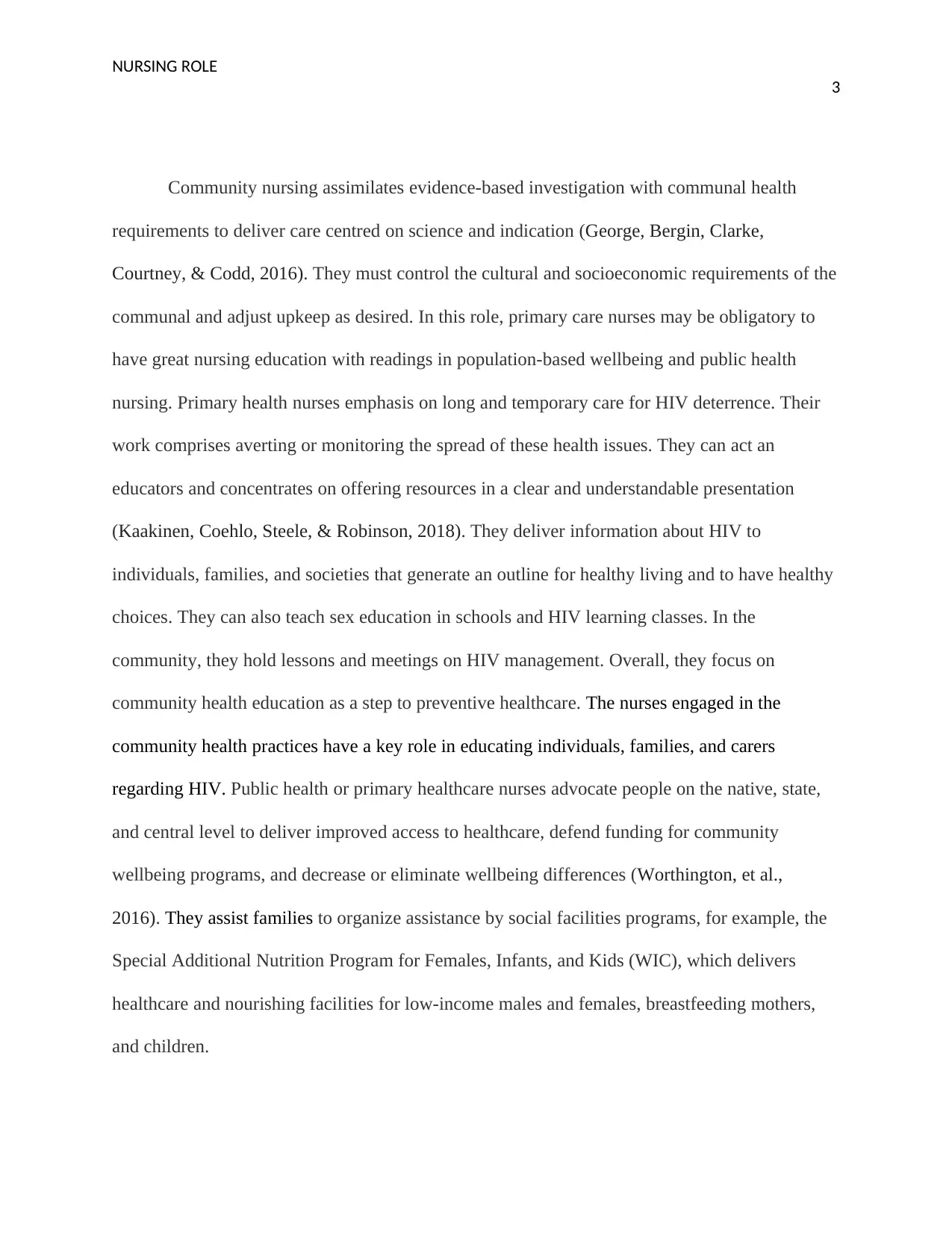
NURSING ROLE
3
Community nursing assimilates evidence-based investigation with communal health
requirements to deliver care centred on science and indication (George, Bergin, Clarke,
Courtney, & Codd, 2016). They must control the cultural and socioeconomic requirements of the
communal and adjust upkeep as desired. In this role, primary care nurses may be obligatory to
have great nursing education with readings in population-based wellbeing and public health
nursing. Primary health nurses emphasis on long and temporary care for HIV deterrence. Their
work comprises averting or monitoring the spread of these health issues. They can act an
educators and concentrates on offering resources in a clear and understandable presentation
(Kaakinen, Coehlo, Steele, & Robinson, 2018). They deliver information about HIV to
individuals, families, and societies that generate an outline for healthy living and to have healthy
choices. They can also teach sex education in schools and HIV learning classes. In the
community, they hold lessons and meetings on HIV management. Overall, they focus on
community health education as a step to preventive healthcare. The nurses engaged in the
community health practices have a key role in educating individuals, families, and carers
regarding HIV. Public health or primary healthcare nurses advocate people on the native, state,
and central level to deliver improved access to healthcare, defend funding for community
wellbeing programs, and decrease or eliminate wellbeing differences (Worthington, et al.,
2016). They assist families to organize assistance by social facilities programs, for example, the
Special Additional Nutrition Program for Females, Infants, and Kids (WIC), which delivers
healthcare and nourishing facilities for low-income males and females, breastfeeding mothers,
and children.
3
Community nursing assimilates evidence-based investigation with communal health
requirements to deliver care centred on science and indication (George, Bergin, Clarke,
Courtney, & Codd, 2016). They must control the cultural and socioeconomic requirements of the
communal and adjust upkeep as desired. In this role, primary care nurses may be obligatory to
have great nursing education with readings in population-based wellbeing and public health
nursing. Primary health nurses emphasis on long and temporary care for HIV deterrence. Their
work comprises averting or monitoring the spread of these health issues. They can act an
educators and concentrates on offering resources in a clear and understandable presentation
(Kaakinen, Coehlo, Steele, & Robinson, 2018). They deliver information about HIV to
individuals, families, and societies that generate an outline for healthy living and to have healthy
choices. They can also teach sex education in schools and HIV learning classes. In the
community, they hold lessons and meetings on HIV management. Overall, they focus on
community health education as a step to preventive healthcare. The nurses engaged in the
community health practices have a key role in educating individuals, families, and carers
regarding HIV. Public health or primary healthcare nurses advocate people on the native, state,
and central level to deliver improved access to healthcare, defend funding for community
wellbeing programs, and decrease or eliminate wellbeing differences (Worthington, et al.,
2016). They assist families to organize assistance by social facilities programs, for example, the
Special Additional Nutrition Program for Females, Infants, and Kids (WIC), which delivers
healthcare and nourishing facilities for low-income males and females, breastfeeding mothers,
and children.
Paraphrase This Document
Need a fresh take? Get an instant paraphrase of this document with our AI Paraphraser

NURSING ROLE
4
Community health care nurses perform manifold functions in HIV related programmes,
counting referring communal associates for HIV analysis, connecting them to upkeep, conveying
them to hospital appointments, delivering psychosocial provision and making recommendations
to other facilities (George, Bergin, Clarke, Courtney, & Codd, 2016). Primary health care nurses
or community nurses have been exposed to advance commitment of HIV facilities and
management adherence in varied settings (Caine, et al., 2016). Community health care providers
or nurses enhance the programme efficiency depends on an allowing work atmosphere for other
health care providers or co-workers counting workload, helpful supervision, provisions and
equipment and admiration from communal members, in addition to locally compassionate social
standards and health guidelines (Kumar, 2016). Community health care nurses or community
nurse can become idol leaders for other health care provider and guide them to provide their
services at individual, families and community levels. Nurses are the link between the
government and the people as they act like a carrier or services initiated by the federal or local
government for the prevention of HIV (Rachlis, et al., 2016).
The symptoms associated with HIV are varying depending on the phase of infection.
However individuals suffering from HIV incline to be most contagious in the initial few months,
numerous are uninformed of their status till later phases (Hellmuth, et al., 2016). The principal
few weeks' afterwards first infection, persons might experience no indications or an influenza-
like disease counting fever, pain, rash, or sore throat. Occasionally persons living with HIV
obligate pre-existing situations that might have subsidized to their threat for HIV contamination.
These circumstances can occasionally make difficulties in HIV management if not addressed
properly (Poindexter, 2016). Among all these situations are mental wellbeing problems, alcohol
usage, and drug usage. The hazard of HIV contamination is advanced among individuals who are
4
Community health care nurses perform manifold functions in HIV related programmes,
counting referring communal associates for HIV analysis, connecting them to upkeep, conveying
them to hospital appointments, delivering psychosocial provision and making recommendations
to other facilities (George, Bergin, Clarke, Courtney, & Codd, 2016). Primary health care nurses
or community nurses have been exposed to advance commitment of HIV facilities and
management adherence in varied settings (Caine, et al., 2016). Community health care providers
or nurses enhance the programme efficiency depends on an allowing work atmosphere for other
health care providers or co-workers counting workload, helpful supervision, provisions and
equipment and admiration from communal members, in addition to locally compassionate social
standards and health guidelines (Kumar, 2016). Community health care nurses or community
nurse can become idol leaders for other health care provider and guide them to provide their
services at individual, families and community levels. Nurses are the link between the
government and the people as they act like a carrier or services initiated by the federal or local
government for the prevention of HIV (Rachlis, et al., 2016).
The symptoms associated with HIV are varying depending on the phase of infection.
However individuals suffering from HIV incline to be most contagious in the initial few months,
numerous are uninformed of their status till later phases (Hellmuth, et al., 2016). The principal
few weeks' afterwards first infection, persons might experience no indications or an influenza-
like disease counting fever, pain, rash, or sore throat. Occasionally persons living with HIV
obligate pre-existing situations that might have subsidized to their threat for HIV contamination.
These circumstances can occasionally make difficulties in HIV management if not addressed
properly (Poindexter, 2016). Among all these situations are mental wellbeing problems, alcohol
usage, and drug usage. The hazard of HIV contamination is advanced among individuals who are
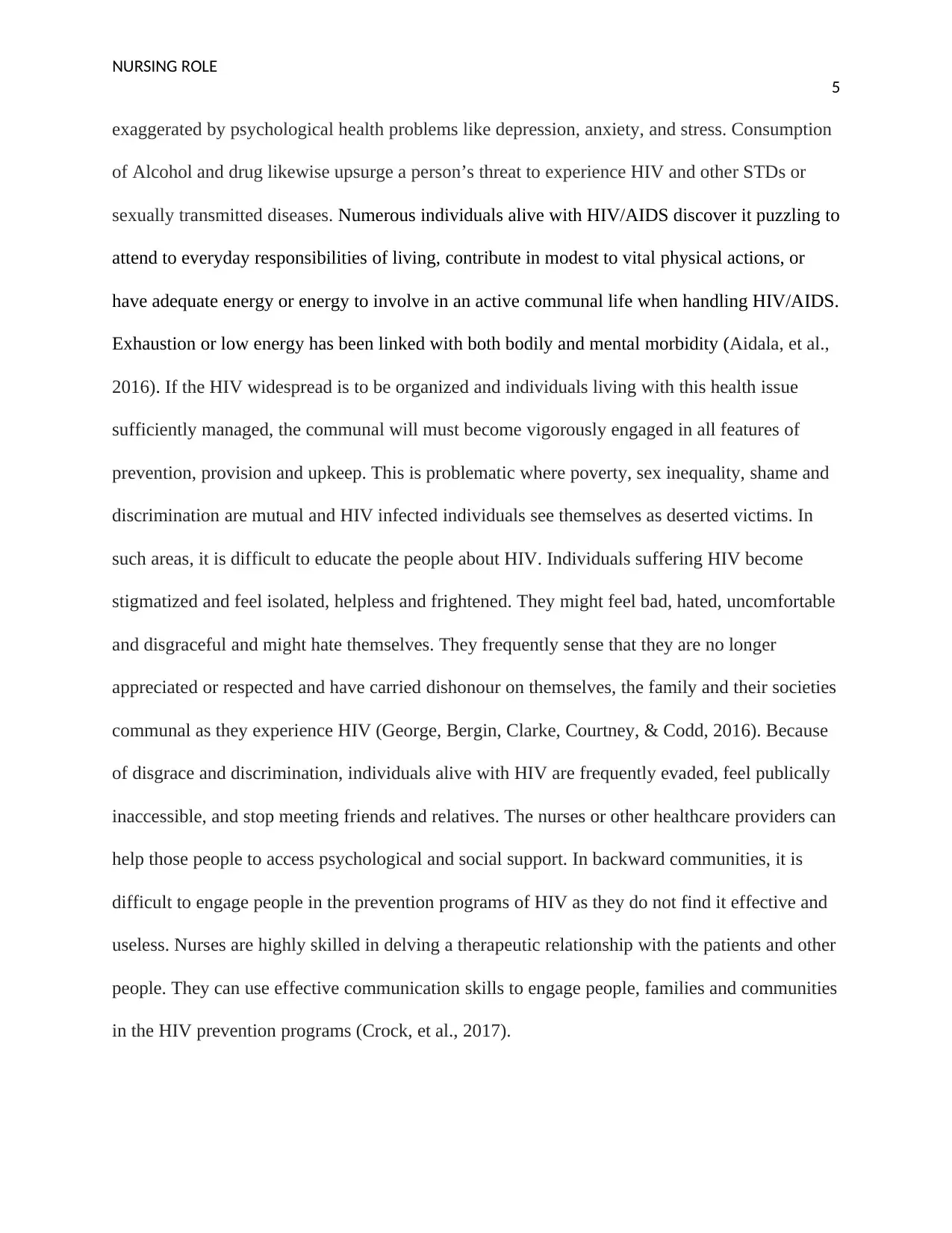
NURSING ROLE
5
exaggerated by psychological health problems like depression, anxiety, and stress. Consumption
of Alcohol and drug likewise upsurge a person’s threat to experience HIV and other STDs or
sexually transmitted diseases. Numerous individuals alive with HIV/AIDS discover it puzzling to
attend to everyday responsibilities of living, contribute in modest to vital physical actions, or
have adequate energy or energy to involve in an active communal life when handling HIV/AIDS.
Exhaustion or low energy has been linked with both bodily and mental morbidity (Aidala, et al.,
2016). If the HIV widespread is to be organized and individuals living with this health issue
sufficiently managed, the communal will must become vigorously engaged in all features of
prevention, provision and upkeep. This is problematic where poverty, sex inequality, shame and
discrimination are mutual and HIV infected individuals see themselves as deserted victims. In
such areas, it is difficult to educate the people about HIV. Individuals suffering HIV become
stigmatized and feel isolated, helpless and frightened. They might feel bad, hated, uncomfortable
and disgraceful and might hate themselves. They frequently sense that they are no longer
appreciated or respected and have carried dishonour on themselves, the family and their societies
communal as they experience HIV (George, Bergin, Clarke, Courtney, & Codd, 2016). Because
of disgrace and discrimination, individuals alive with HIV are frequently evaded, feel publically
inaccessible, and stop meeting friends and relatives. The nurses or other healthcare providers can
help those people to access psychological and social support. In backward communities, it is
difficult to engage people in the prevention programs of HIV as they do not find it effective and
useless. Nurses are highly skilled in delving a therapeutic relationship with the patients and other
people. They can use effective communication skills to engage people, families and communities
in the HIV prevention programs (Crock, et al., 2017).
5
exaggerated by psychological health problems like depression, anxiety, and stress. Consumption
of Alcohol and drug likewise upsurge a person’s threat to experience HIV and other STDs or
sexually transmitted diseases. Numerous individuals alive with HIV/AIDS discover it puzzling to
attend to everyday responsibilities of living, contribute in modest to vital physical actions, or
have adequate energy or energy to involve in an active communal life when handling HIV/AIDS.
Exhaustion or low energy has been linked with both bodily and mental morbidity (Aidala, et al.,
2016). If the HIV widespread is to be organized and individuals living with this health issue
sufficiently managed, the communal will must become vigorously engaged in all features of
prevention, provision and upkeep. This is problematic where poverty, sex inequality, shame and
discrimination are mutual and HIV infected individuals see themselves as deserted victims. In
such areas, it is difficult to educate the people about HIV. Individuals suffering HIV become
stigmatized and feel isolated, helpless and frightened. They might feel bad, hated, uncomfortable
and disgraceful and might hate themselves. They frequently sense that they are no longer
appreciated or respected and have carried dishonour on themselves, the family and their societies
communal as they experience HIV (George, Bergin, Clarke, Courtney, & Codd, 2016). Because
of disgrace and discrimination, individuals alive with HIV are frequently evaded, feel publically
inaccessible, and stop meeting friends and relatives. The nurses or other healthcare providers can
help those people to access psychological and social support. In backward communities, it is
difficult to engage people in the prevention programs of HIV as they do not find it effective and
useless. Nurses are highly skilled in delving a therapeutic relationship with the patients and other
people. They can use effective communication skills to engage people, families and communities
in the HIV prevention programs (Crock, et al., 2017).
⊘ This is a preview!⊘
Do you want full access?
Subscribe today to unlock all pages.

Trusted by 1+ million students worldwide
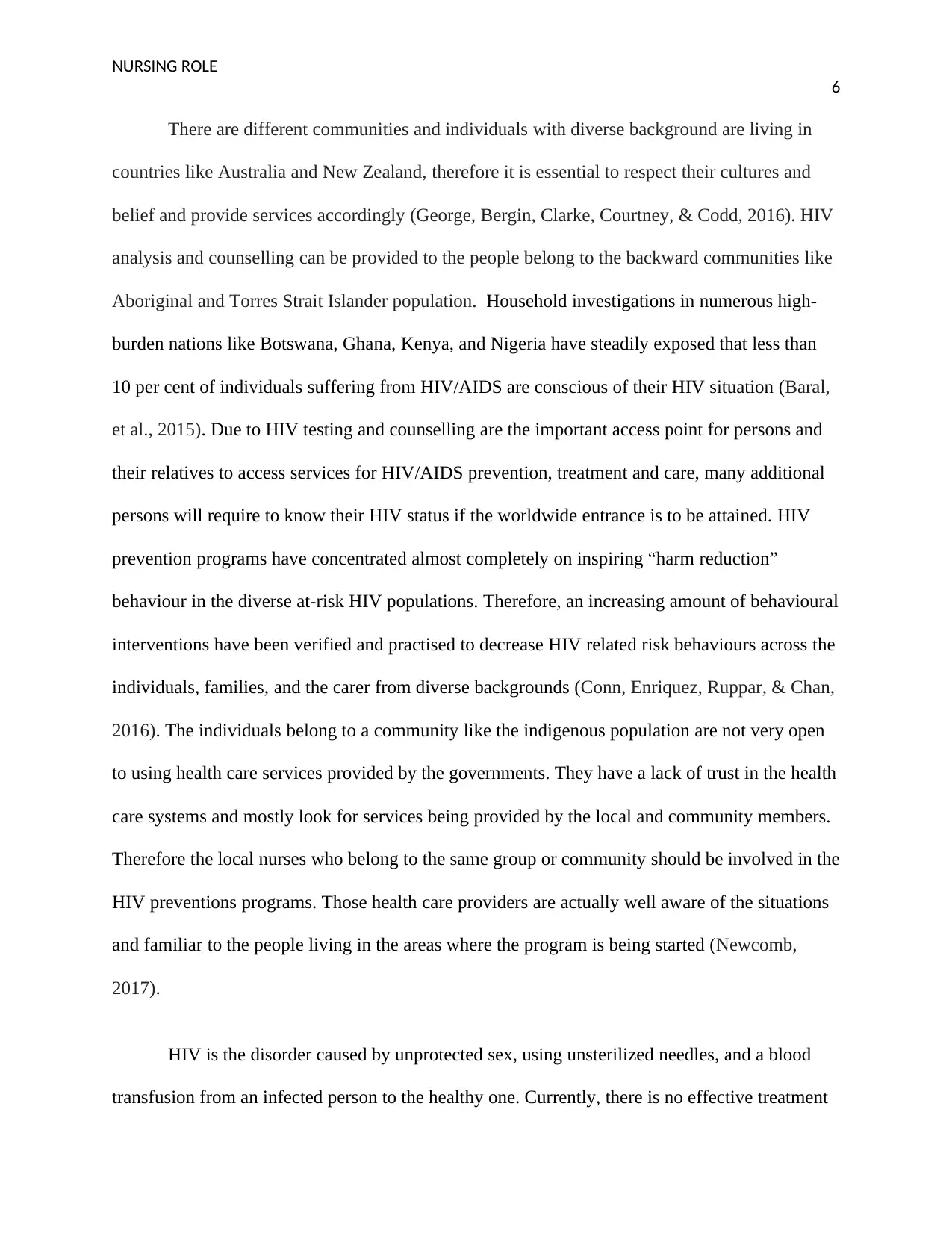
NURSING ROLE
6
There are different communities and individuals with diverse background are living in
countries like Australia and New Zealand, therefore it is essential to respect their cultures and
belief and provide services accordingly (George, Bergin, Clarke, Courtney, & Codd, 2016). HIV
analysis and counselling can be provided to the people belong to the backward communities like
Aboriginal and Torres Strait Islander population. Household investigations in numerous high-
burden nations like Botswana, Ghana, Kenya, and Nigeria have steadily exposed that less than
10 per cent of individuals suffering from HIV/AIDS are conscious of their HIV situation (Baral,
et al., 2015). Due to HIV testing and counselling are the important access point for persons and
their relatives to access services for HIV/AIDS prevention, treatment and care, many additional
persons will require to know their HIV status if the worldwide entrance is to be attained. HIV
prevention programs have concentrated almost completely on inspiring “harm reduction”
behaviour in the diverse at-risk HIV populations. Therefore, an increasing amount of behavioural
interventions have been verified and practised to decrease HIV related risk behaviours across the
individuals, families, and the carer from diverse backgrounds (Conn, Enriquez, Ruppar, & Chan,
2016). The individuals belong to a community like the indigenous population are not very open
to using health care services provided by the governments. They have a lack of trust in the health
care systems and mostly look for services being provided by the local and community members.
Therefore the local nurses who belong to the same group or community should be involved in the
HIV preventions programs. Those health care providers are actually well aware of the situations
and familiar to the people living in the areas where the program is being started (Newcomb,
2017).
HIV is the disorder caused by unprotected sex, using unsterilized needles, and a blood
transfusion from an infected person to the healthy one. Currently, there is no effective treatment
6
There are different communities and individuals with diverse background are living in
countries like Australia and New Zealand, therefore it is essential to respect their cultures and
belief and provide services accordingly (George, Bergin, Clarke, Courtney, & Codd, 2016). HIV
analysis and counselling can be provided to the people belong to the backward communities like
Aboriginal and Torres Strait Islander population. Household investigations in numerous high-
burden nations like Botswana, Ghana, Kenya, and Nigeria have steadily exposed that less than
10 per cent of individuals suffering from HIV/AIDS are conscious of their HIV situation (Baral,
et al., 2015). Due to HIV testing and counselling are the important access point for persons and
their relatives to access services for HIV/AIDS prevention, treatment and care, many additional
persons will require to know their HIV status if the worldwide entrance is to be attained. HIV
prevention programs have concentrated almost completely on inspiring “harm reduction”
behaviour in the diverse at-risk HIV populations. Therefore, an increasing amount of behavioural
interventions have been verified and practised to decrease HIV related risk behaviours across the
individuals, families, and the carer from diverse backgrounds (Conn, Enriquez, Ruppar, & Chan,
2016). The individuals belong to a community like the indigenous population are not very open
to using health care services provided by the governments. They have a lack of trust in the health
care systems and mostly look for services being provided by the local and community members.
Therefore the local nurses who belong to the same group or community should be involved in the
HIV preventions programs. Those health care providers are actually well aware of the situations
and familiar to the people living in the areas where the program is being started (Newcomb,
2017).
HIV is the disorder caused by unprotected sex, using unsterilized needles, and a blood
transfusion from an infected person to the healthy one. Currently, there is no effective treatment
Paraphrase This Document
Need a fresh take? Get an instant paraphrase of this document with our AI Paraphraser
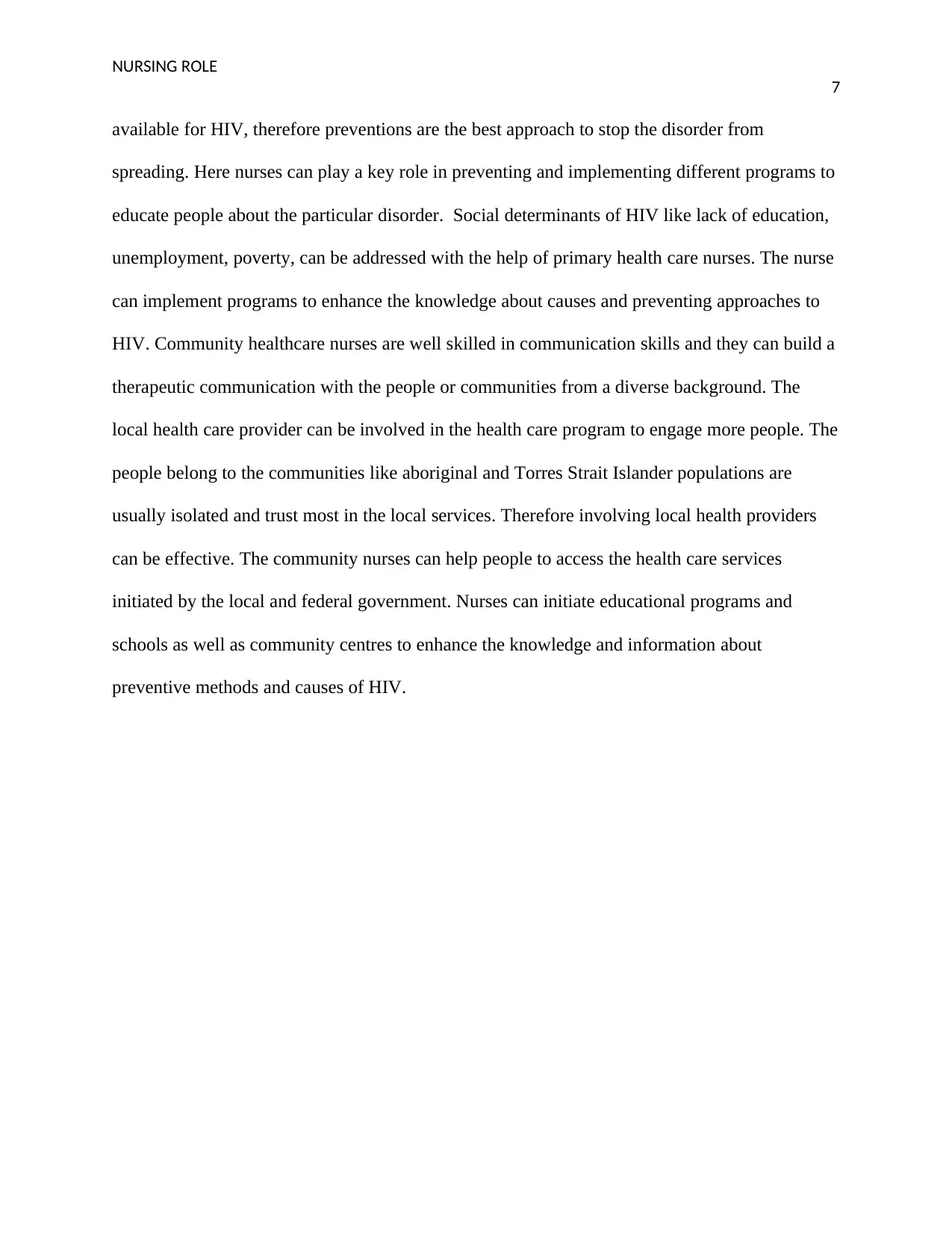
NURSING ROLE
7
available for HIV, therefore preventions are the best approach to stop the disorder from
spreading. Here nurses can play a key role in preventing and implementing different programs to
educate people about the particular disorder. Social determinants of HIV like lack of education,
unemployment, poverty, can be addressed with the help of primary health care nurses. The nurse
can implement programs to enhance the knowledge about causes and preventing approaches to
HIV. Community healthcare nurses are well skilled in communication skills and they can build a
therapeutic communication with the people or communities from a diverse background. The
local health care provider can be involved in the health care program to engage more people. The
people belong to the communities like aboriginal and Torres Strait Islander populations are
usually isolated and trust most in the local services. Therefore involving local health providers
can be effective. The community nurses can help people to access the health care services
initiated by the local and federal government. Nurses can initiate educational programs and
schools as well as community centres to enhance the knowledge and information about
preventive methods and causes of HIV.
7
available for HIV, therefore preventions are the best approach to stop the disorder from
spreading. Here nurses can play a key role in preventing and implementing different programs to
educate people about the particular disorder. Social determinants of HIV like lack of education,
unemployment, poverty, can be addressed with the help of primary health care nurses. The nurse
can implement programs to enhance the knowledge about causes and preventing approaches to
HIV. Community healthcare nurses are well skilled in communication skills and they can build a
therapeutic communication with the people or communities from a diverse background. The
local health care provider can be involved in the health care program to engage more people. The
people belong to the communities like aboriginal and Torres Strait Islander populations are
usually isolated and trust most in the local services. Therefore involving local health providers
can be effective. The community nurses can help people to access the health care services
initiated by the local and federal government. Nurses can initiate educational programs and
schools as well as community centres to enhance the knowledge and information about
preventive methods and causes of HIV.

NURSING ROLE
8
References
Aidala, A. A., Wilson, M. G., Shubert, V., Gogolishvili, D., Globerman, J., Rueda, S., & Rourke,
S. B. (2016). Housing status, medical care, and health outcomes among people living
with HIV/AIDS: a systematic review. American Journal of Public Health, 106(1), e1-
e23.
Baral, S. D., Friedman, M. R., Geibel, S., Rebe, K., Bozhinov, B., Diouf, D., & Cáceres, C. F.
(2015). Male sex workers: practices, contexts, and vulnerabilities for HIV acquisition and
transmission. The Lancet, 385(9964), 260-273.
Brown, G., Reeders, D., Dowsett, G. W., Ellard, J., Carman, M., Hendry, N., & Wallace, J.
(2015). Investigating combination HIV prevention: isolated interventions or complex
system. Journal of the International AIDS Society, 18(1), 20499.
Caine, V., Mill, J., O'brien, K., Solomon, P., Worthington, C., Dykeman, M., & Rogers, T.
(2016). Implementation process of a Canadian community-based nurse mentorship
intervention in HIV care. Journal of the Association of Nurses in AIDS Care, 27(3), 274-
284.
Conn, V. S., Enriquez, M., Ruppar, T. M., & Chan, K. C. (2016). Meta-analyses of theory use in
medication adherence intervention research. American journal of health behavior, 40(2),
155-171.
Crock, E. A., Miller, C., McKenzie, R., Burk, N., Frecker, J., Hall, J. E., & Ramirez, O. M.
(2017). Emerging Needs of People Living With HIV Receiving Community-Based
8
References
Aidala, A. A., Wilson, M. G., Shubert, V., Gogolishvili, D., Globerman, J., Rueda, S., & Rourke,
S. B. (2016). Housing status, medical care, and health outcomes among people living
with HIV/AIDS: a systematic review. American Journal of Public Health, 106(1), e1-
e23.
Baral, S. D., Friedman, M. R., Geibel, S., Rebe, K., Bozhinov, B., Diouf, D., & Cáceres, C. F.
(2015). Male sex workers: practices, contexts, and vulnerabilities for HIV acquisition and
transmission. The Lancet, 385(9964), 260-273.
Brown, G., Reeders, D., Dowsett, G. W., Ellard, J., Carman, M., Hendry, N., & Wallace, J.
(2015). Investigating combination HIV prevention: isolated interventions or complex
system. Journal of the International AIDS Society, 18(1), 20499.
Caine, V., Mill, J., O'brien, K., Solomon, P., Worthington, C., Dykeman, M., & Rogers, T.
(2016). Implementation process of a Canadian community-based nurse mentorship
intervention in HIV care. Journal of the Association of Nurses in AIDS Care, 27(3), 274-
284.
Conn, V. S., Enriquez, M., Ruppar, T. M., & Chan, K. C. (2016). Meta-analyses of theory use in
medication adherence intervention research. American journal of health behavior, 40(2),
155-171.
Crock, E. A., Miller, C., McKenzie, R., Burk, N., Frecker, J., Hall, J. E., & Ramirez, O. M.
(2017). Emerging Needs of People Living With HIV Receiving Community-Based
⊘ This is a preview!⊘
Do you want full access?
Subscribe today to unlock all pages.

Trusted by 1+ million students worldwide
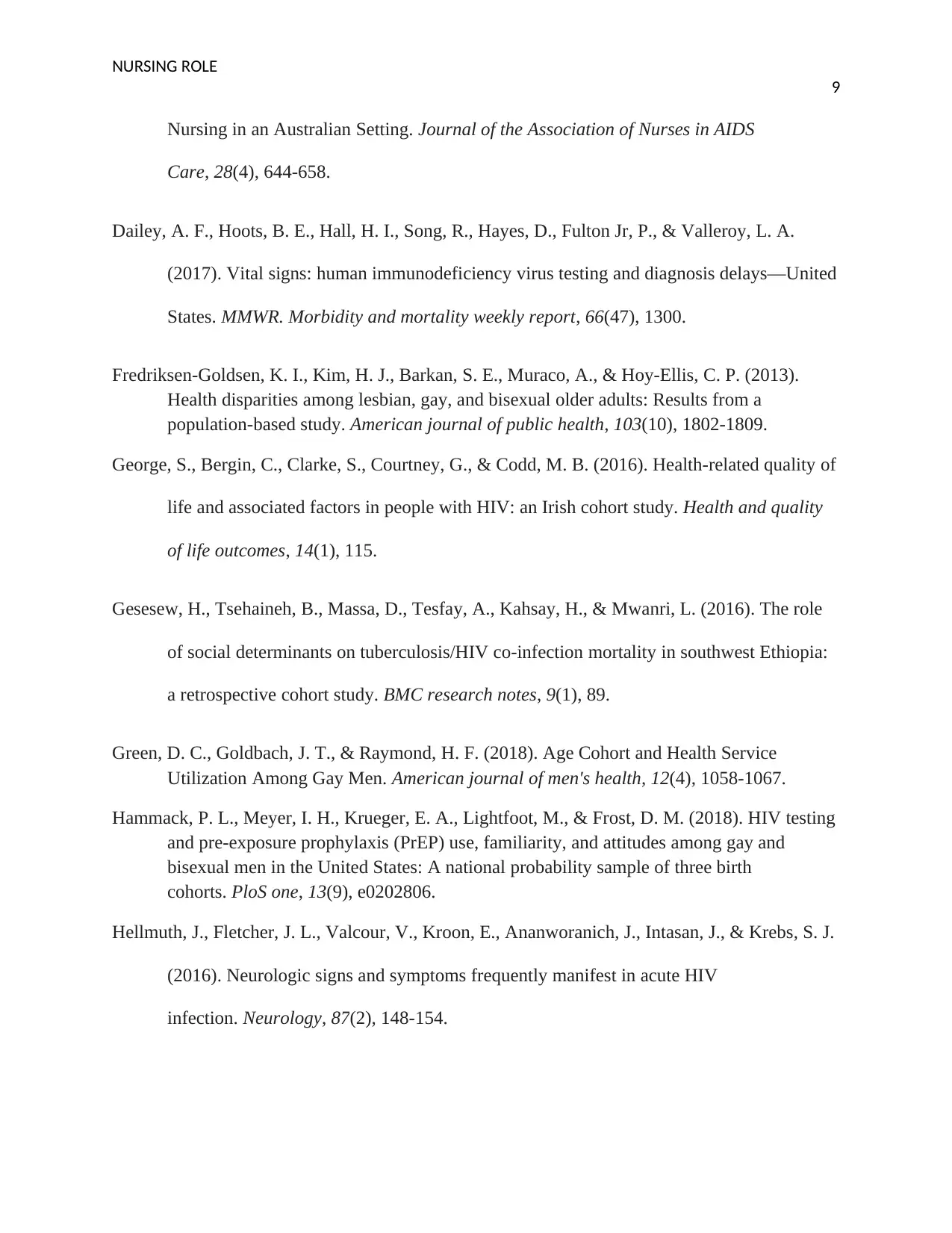
NURSING ROLE
9
Nursing in an Australian Setting. Journal of the Association of Nurses in AIDS
Care, 28(4), 644-658.
Dailey, A. F., Hoots, B. E., Hall, H. I., Song, R., Hayes, D., Fulton Jr, P., & Valleroy, L. A.
(2017). Vital signs: human immunodeficiency virus testing and diagnosis delays—United
States. MMWR. Morbidity and mortality weekly report, 66(47), 1300.
Fredriksen-Goldsen, K. I., Kim, H. J., Barkan, S. E., Muraco, A., & Hoy-Ellis, C. P. (2013).
Health disparities among lesbian, gay, and bisexual older adults: Results from a
population-based study. American journal of public health, 103(10), 1802-1809.
George, S., Bergin, C., Clarke, S., Courtney, G., & Codd, M. B. (2016). Health-related quality of
life and associated factors in people with HIV: an Irish cohort study. Health and quality
of life outcomes, 14(1), 115.
Gesesew, H., Tsehaineh, B., Massa, D., Tesfay, A., Kahsay, H., & Mwanri, L. (2016). The role
of social determinants on tuberculosis/HIV co-infection mortality in southwest Ethiopia:
a retrospective cohort study. BMC research notes, 9(1), 89.
Green, D. C., Goldbach, J. T., & Raymond, H. F. (2018). Age Cohort and Health Service
Utilization Among Gay Men. American journal of men's health, 12(4), 1058-1067.
Hammack, P. L., Meyer, I. H., Krueger, E. A., Lightfoot, M., & Frost, D. M. (2018). HIV testing
and pre-exposure prophylaxis (PrEP) use, familiarity, and attitudes among gay and
bisexual men in the United States: A national probability sample of three birth
cohorts. PloS one, 13(9), e0202806.
Hellmuth, J., Fletcher, J. L., Valcour, V., Kroon, E., Ananworanich, J., Intasan, J., & Krebs, S. J.
(2016). Neurologic signs and symptoms frequently manifest in acute HIV
infection. Neurology, 87(2), 148-154.
9
Nursing in an Australian Setting. Journal of the Association of Nurses in AIDS
Care, 28(4), 644-658.
Dailey, A. F., Hoots, B. E., Hall, H. I., Song, R., Hayes, D., Fulton Jr, P., & Valleroy, L. A.
(2017). Vital signs: human immunodeficiency virus testing and diagnosis delays—United
States. MMWR. Morbidity and mortality weekly report, 66(47), 1300.
Fredriksen-Goldsen, K. I., Kim, H. J., Barkan, S. E., Muraco, A., & Hoy-Ellis, C. P. (2013).
Health disparities among lesbian, gay, and bisexual older adults: Results from a
population-based study. American journal of public health, 103(10), 1802-1809.
George, S., Bergin, C., Clarke, S., Courtney, G., & Codd, M. B. (2016). Health-related quality of
life and associated factors in people with HIV: an Irish cohort study. Health and quality
of life outcomes, 14(1), 115.
Gesesew, H., Tsehaineh, B., Massa, D., Tesfay, A., Kahsay, H., & Mwanri, L. (2016). The role
of social determinants on tuberculosis/HIV co-infection mortality in southwest Ethiopia:
a retrospective cohort study. BMC research notes, 9(1), 89.
Green, D. C., Goldbach, J. T., & Raymond, H. F. (2018). Age Cohort and Health Service
Utilization Among Gay Men. American journal of men's health, 12(4), 1058-1067.
Hammack, P. L., Meyer, I. H., Krueger, E. A., Lightfoot, M., & Frost, D. M. (2018). HIV testing
and pre-exposure prophylaxis (PrEP) use, familiarity, and attitudes among gay and
bisexual men in the United States: A national probability sample of three birth
cohorts. PloS one, 13(9), e0202806.
Hellmuth, J., Fletcher, J. L., Valcour, V., Kroon, E., Ananworanich, J., Intasan, J., & Krebs, S. J.
(2016). Neurologic signs and symptoms frequently manifest in acute HIV
infection. Neurology, 87(2), 148-154.
Paraphrase This Document
Need a fresh take? Get an instant paraphrase of this document with our AI Paraphraser
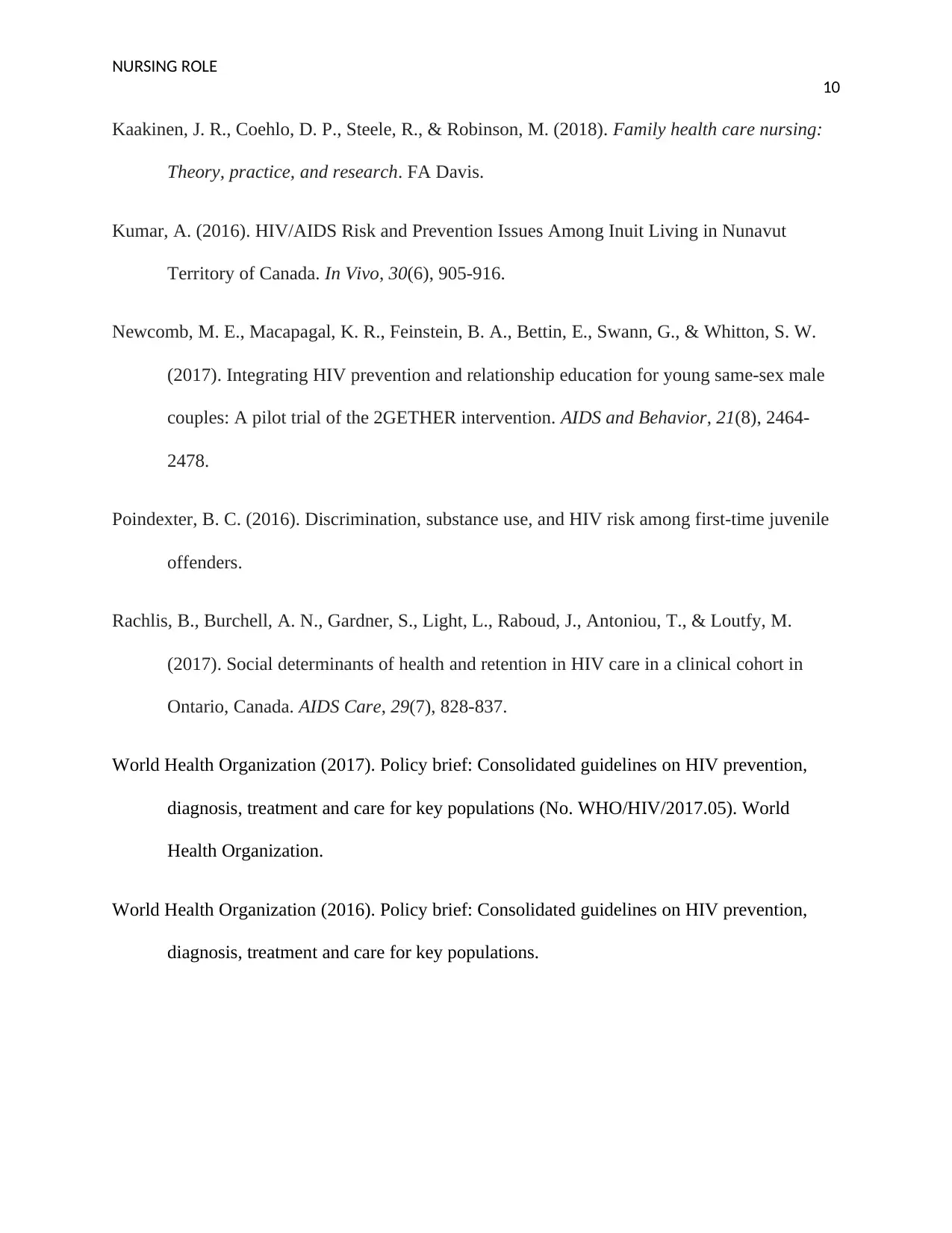
NURSING ROLE
10
Kaakinen, J. R., Coehlo, D. P., Steele, R., & Robinson, M. (2018). Family health care nursing:
Theory, practice, and research. FA Davis.
Kumar, A. (2016). HIV/AIDS Risk and Prevention Issues Among Inuit Living in Nunavut
Territory of Canada. In Vivo, 30(6), 905-916.
Newcomb, M. E., Macapagal, K. R., Feinstein, B. A., Bettin, E., Swann, G., & Whitton, S. W.
(2017). Integrating HIV prevention and relationship education for young same-sex male
couples: A pilot trial of the 2GETHER intervention. AIDS and Behavior, 21(8), 2464-
2478.
Poindexter, B. C. (2016). Discrimination, substance use, and HIV risk among first-time juvenile
offenders.
Rachlis, B., Burchell, A. N., Gardner, S., Light, L., Raboud, J., Antoniou, T., & Loutfy, M.
(2017). Social determinants of health and retention in HIV care in a clinical cohort in
Ontario, Canada. AIDS Care, 29(7), 828-837.
World Health Organization (2017). Policy brief: Consolidated guidelines on HIV prevention,
diagnosis, treatment and care for key populations (No. WHO/HIV/2017.05). World
Health Organization.
World Health Organization (2016). Policy brief: Consolidated guidelines on HIV prevention,
diagnosis, treatment and care for key populations.
10
Kaakinen, J. R., Coehlo, D. P., Steele, R., & Robinson, M. (2018). Family health care nursing:
Theory, practice, and research. FA Davis.
Kumar, A. (2016). HIV/AIDS Risk and Prevention Issues Among Inuit Living in Nunavut
Territory of Canada. In Vivo, 30(6), 905-916.
Newcomb, M. E., Macapagal, K. R., Feinstein, B. A., Bettin, E., Swann, G., & Whitton, S. W.
(2017). Integrating HIV prevention and relationship education for young same-sex male
couples: A pilot trial of the 2GETHER intervention. AIDS and Behavior, 21(8), 2464-
2478.
Poindexter, B. C. (2016). Discrimination, substance use, and HIV risk among first-time juvenile
offenders.
Rachlis, B., Burchell, A. N., Gardner, S., Light, L., Raboud, J., Antoniou, T., & Loutfy, M.
(2017). Social determinants of health and retention in HIV care in a clinical cohort in
Ontario, Canada. AIDS Care, 29(7), 828-837.
World Health Organization (2017). Policy brief: Consolidated guidelines on HIV prevention,
diagnosis, treatment and care for key populations (No. WHO/HIV/2017.05). World
Health Organization.
World Health Organization (2016). Policy brief: Consolidated guidelines on HIV prevention,
diagnosis, treatment and care for key populations.
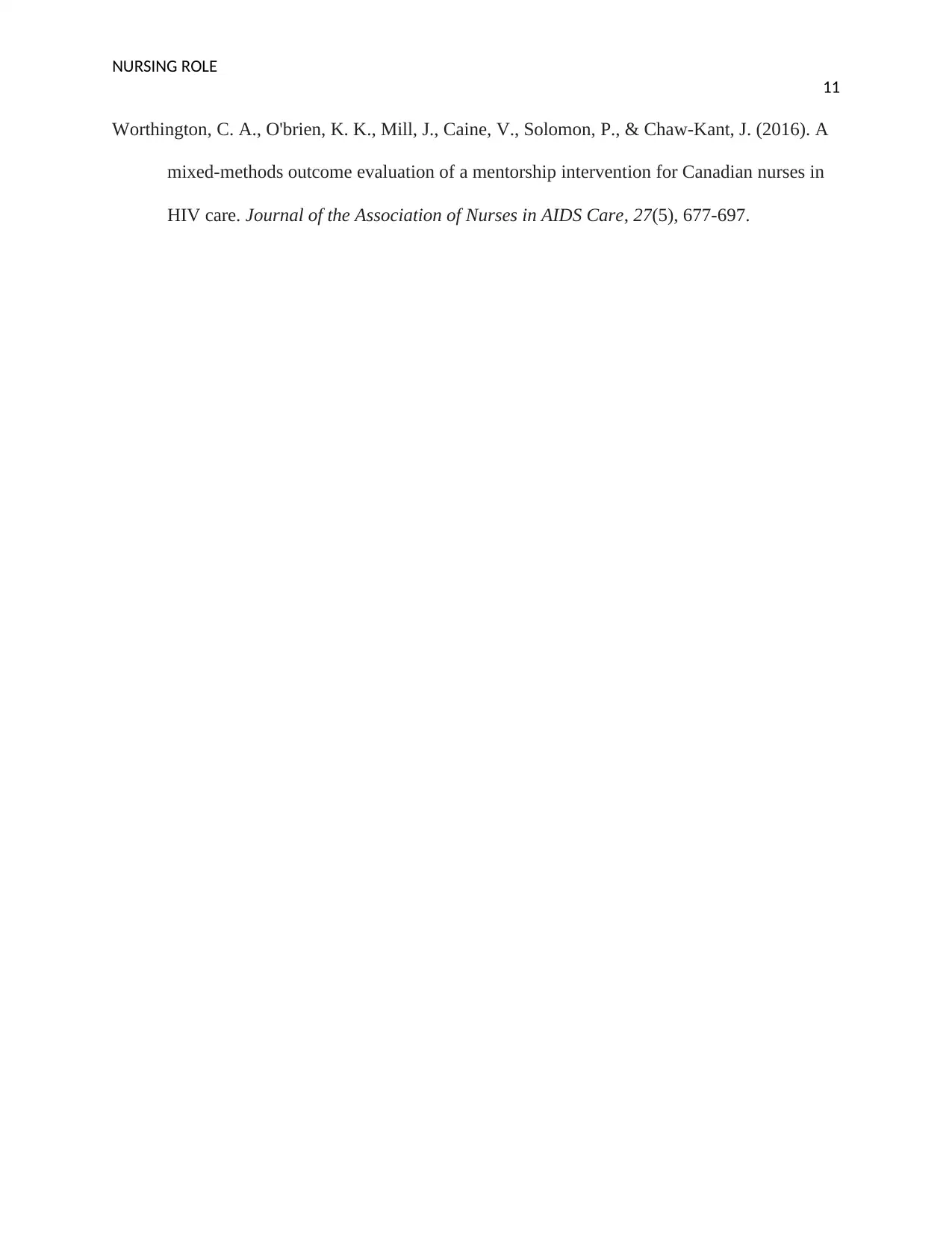
NURSING ROLE
11
Worthington, C. A., O'brien, K. K., Mill, J., Caine, V., Solomon, P., & Chaw-Kant, J. (2016). A
mixed-methods outcome evaluation of a mentorship intervention for Canadian nurses in
HIV care. Journal of the Association of Nurses in AIDS Care, 27(5), 677-697.
11
Worthington, C. A., O'brien, K. K., Mill, J., Caine, V., Solomon, P., & Chaw-Kant, J. (2016). A
mixed-methods outcome evaluation of a mentorship intervention for Canadian nurses in
HIV care. Journal of the Association of Nurses in AIDS Care, 27(5), 677-697.
⊘ This is a preview!⊘
Do you want full access?
Subscribe today to unlock all pages.

Trusted by 1+ million students worldwide
1 out of 12
Related Documents
Your All-in-One AI-Powered Toolkit for Academic Success.
+13062052269
info@desklib.com
Available 24*7 on WhatsApp / Email
![[object Object]](/_next/static/media/star-bottom.7253800d.svg)
Unlock your academic potential
Copyright © 2020–2025 A2Z Services. All Rights Reserved. Developed and managed by ZUCOL.




